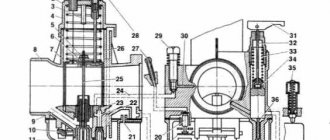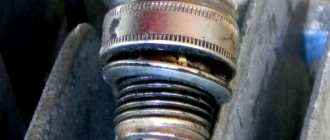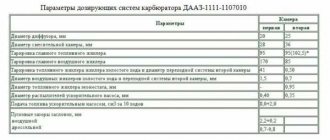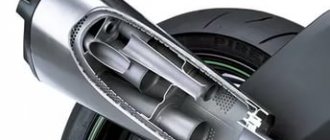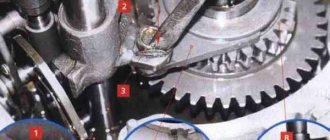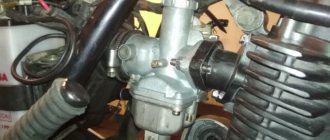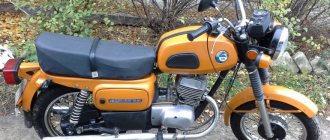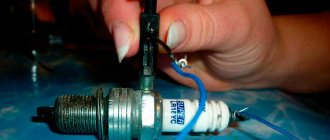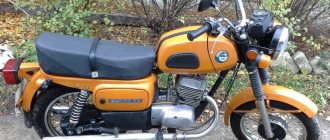Is it possible to install one carburetor on a Ural motorcycle? This question is asked by many owners of popular motorcycles in our country. The reason for this interest is obvious. Ural motorcycles, regardless of the year of manufacture, are standardly equipped with one carburetor for each cylinder. This provides better filling with the combustible mixture, but creates many problems during adjustment.
After all, synchronizing the operation of the cylinders is not an easy task even for an experienced specialist!
Everyone who has at least once adjusted the supply of a fuel mixture in the Urals knows this. Neither the latest domestic model K-68, nor the Japanese analogues from Mikuni are able to solve this problem. Moreover, the general condition of the engine also has an impact.
What carburetors should be installed in the Urals?
I have a Ural with a 750cc engine. The question arose: Which carburetors should be installed in the Urals? Is it worth installing KAIKHEN or other fancy carburetors? Will this be of any use?
It will be, but provided that you have extra $
The rating is approximately like this:
1. Keikhen 2. Mikuni, etc. with constant discharge 3. Bingi and Ikov 4. K-68 5. K-65
You should strive for constant discharge - the dynamics will significantly improve, etc. In general, read something like
1 There is no difference between Keihen and Mikuni in terms of quality. 1.1 If you install them, then adjustments “by ear and eye” will no longer be enough, otherwise they will work no better than all those listed below. There is no need to put 2 Ikov on 750! Diffuser too small. 3 Put k68, find a normal person (with hands) who will rebuild them and that’s it.
Just don't put k-68.
There are very few pretzels with normal hands, and they themselves are shitty carbs.
Read what you write and what advice you give. First you offer imports, and then immediately the worst of the domestic ones. And the carbs are rotten because they weren’t invented with brains and weren’t made with hands. (he excused himself.)
If you install bourgeois ones, you will have to select jets. otherwise there is no point. They were designed for other engines.
And I personally have had 68s for a long time. 5k away. So far so good.. maybe it’s a MARRIAGE)))))
for APEX
: What kind of device do you have?
Chemical industry, why not drive to 68! If moonshine’s hands don’t grow from there! I drilled holes in them and got everything working properly! I also have inertial supercharging, which also improves the quality of the engine! So you just need to not be lazy and rebuild. And drill holes.
How long can we say that 68 are completely different! I had a set (no need to push my hands) that several fairly experienced motorcycle mechanics tried to adjust! If I can give someone something I want! Especially those who are lucky with carbs and run into the wrong hands!
I put 65 since then and in x. I'm not blowing!
Ikov tried it! Atstoy. As for Mikuni and Keihin, I haven’t tried it! But I really liked the Belarusian K2401 at work! True, who the hell knows how they will survive on a 750 cc machine! They say they produce K2801 type for large-displacement engines. It makes sense to try! The carbs are made head-to-head and not taken from the worst ones! That is, with “Pacco”
for Kudesnik
: where did you drill the holes? Can you be more specific. otherwise they hesitated. It’s impossible to rebuild the boost with K68. (or maybe the driver of the hand.sys is not working well) last season the engine was brainwashed... the supercharged K65 works great on the second motorcycle. but they don’t want k68
We'll say goodbye to the Keihin soon. The plant switches to Italian components. The carbs will probably be Dell Orto. And with constant rarefaction - a thrill. Motz stands on the goat with a lever fork. True, if unadapted carbs from the Japanese are a funnel in the tank.
There is no need to drill anything. They had very bad first games, but then they improved. LKZ himself admits this. The main thing is not to buy a new carb from old stocks.
And the first batches were really drilled in order to achieve at least something from them.
Tut byla musl o inerzionnom nadduve, che-to ne ochen veritsa v ego effectivnost, pomoimu nadduv nachinaet effectivnuyu rabotu tolko after 150 km/h .
2 him_prom_death don't bother running into 68 - the best carbs are from the scoop. and you don't need to drill anything into them. Crap! one idiot wrote in motorcycles - half the country is drilling holes. they need to be set up and driven. and so, naturally, with constant discharge it will be better.
for manowar
: Let's say not the best, but the most affordable. Instead of looking for a normal power supply system, you all prove to me that K-68 is Forever. Even without constant discharge. you can find a good carb. (the same RASSO: K-2401: worse than jikov and even worse than K-65) BUT NOT LIKE K-68
for manowar
: You’re from Moscow, so you should know the store on Aviamotornaya. Go there and consult with Khorok about this, and you’ll see the prices for one thing. (say it’s from Him.)
People, Voyage checkpoint is urgently needed. Send suggestions to [email protected] (thanks in advance.)
for biker980
: This is not the boost you thought about. This is probably a synchronizer. On the contrary, it only works on the lower levels.
Thank you all so much for your advice. See you
Mikuni for each boiler, and go ahead to conquer the peaks of Everest. /may overflow a little/
Mikuni are worth big bucks, however! Six times more expensive than the K-68, which, by the way, I spent the season with without any problems.
Indeed, the quality of carbs depends only on which heel of the worker Ivanov at Lenkarz was bitten by a fruit fly and how much he drank yesterday. I do not argue. But the holes are still not superfluous. because if they are provided for by the design, and some smart guy decided not to drill them, “because it’s cooler,” then this does not mean that in fact, they exist. With the needles raised as high as possible, my candles still remained white. And he didn’t drive at all. Drilled it - everything is ok! you just need to be careful.
Pochem seychas mikuni v Moscow?
for him_prom_death
: I think that everyone knows me there anyway. and now about the carbs: the 68 is not such crap as you, sir, put it. Of the available, widespread ones, it’s the most. If there are other opinions, I’ll give you a pair of any 68, I’ll put it on my rat, I’ll rebuild it and then we’ll check yours. if not a constant discharge, then I think after the adjustment I will have a better result. I don’t recommend changing 68 carburetors, much less drilling them out. those who hate 68 in favor of 65 and older ones simply do not know how to configure them. that's all. What are we talking about here? For those who have 65, I don’t encourage changing them to 68; 68, in my opinion, only has more stable long-term tuning parameters and idle speed. and I sympathize with those pretzels who exchange 68 for older ones.
for biker980
: You can really get a pair for 100. Naturally used and unknown in what condition
for biker980
: You can really get a pair for 100. Naturally used and unknown in what condition
I'll report shortly. I installed Yikovs from Java638 on the Volk (before that I drove a K-68) There was clearly no deterioration or improvement in driving performance - I did not find it. Nevertheless, there are certain advantages - the launch is much better. It spins better (in terms of rpm). The failure is smaller (well, this is completely subjective, it may seem) As for fuel consumption, I have not yet measured it. But I repeat - the bike rides exactly the same as with the K-68. THAT'S SO FUCK.
what were you waiting for? with ordinary carbs, everything will be more or less averagely lousy. Expect a significant improvement in performance only when you install a constant discharge. and even then, you will have to select jets.
About 68 I can confirm that it depends. Either from the phases of the moon, or from some other cycles. We already have a whole collection of them. Some are no good, others (although very similar) are fine. PHENOMENON, dammit.
By the way, everyone here says that you need to configure something special, but what exactly are the features, if not a secret?
A skoka v isvestnom i horoshem sostoianii nado otvalit $$$ ?
So here's the rub:
1. Let's assume K68 is a sane carb
2. K2801 full rulez incl. by price
Question: for some reason he doesn’t drive enough on p2. People gravitate towards p1.
Main question. In the 650 engine with the new type of heads, the carb mounts are at an angle. I haven't tried it yet, but I suspect it will affect their performance. Who is more stable p1 or p2. (XX, acceleration, consumption, etc.)
for Devol
: all because p1 satisfies the people (not in the sense of 100%, just satisfactory carbs, C plus or minus four). Yes, even 2801 will be better, but you need to buy it, install it, configure it and get a slight improvement.
>>But I really liked the Belarusian K2401.
Installing one carburetor on a Ural motorcycle
Is it possible to install one carburetor on a Ural motorcycle? This question is asked by many owners of popular motorcycles in our country. The reason for this interest is obvious. Ural motorcycles, regardless of the year of manufacture, are standardly equipped with one carburetor for each cylinder. This provides better filling with the combustible mixture, but creates many problems during adjustment.
What to do
Installing one carburetor largely solves this problem. This is a possible, although not ideal, solution. In bringing the plan to life, certain difficulties will have to be overcome. Necessary:
- Clear space above the engine crankcase. This is where it is most convenient to secure the intake tract and connecting flange.
- Make an intake manifold.
- Select a suitable carburetor according to the parameters.
All this will require a significant investment of time and money.
Inappropriate option
What carburetors are suitable and what is better to install? We will have to disappoint those who plan to use available models from Oka or Zhiguli during the conversion. All car modifications are out of play in this case. There are several reasons:
- The vacuum in the intake tract of a motorcycle differs from the parameters typical for car engines. Because of this, correct adjustment of the carburetor on a motorcycle becomes almost impossible.
- The selection is carried out not simply by working volume, but by the number of aspirations per unit of time. Aspiration can be roughly calculated by multiplying the engine displacement by the maximum speed.
- Car models pose a danger if the motorcycle falls because fuel can splash out and ignite.
So the idea of using parts from Oka or other automotive equipment will have to be abandoned.
This is interesting: How to close the starter directly on a VAZ 2110
Adjusting mixture enrichment
Before starting adjustments, be it the carburetor model K 65 of the Ural, Dnepr motorcycle, Buran snowmobile or other vehicles, the engine should be warmed up.
Then the minimum stable idle speed is set. To do this, use the screw to lower the throttle. Afterwards you need to increase the number of revolutions to the maximum possible. The screw is rotated in one direction or another.
Slowly the speed is again reduced and increased. This should be done 2-3 times.
After the manipulations, you should check how the engine reacts to the position of the throttle. To understand how to set up the K 65 carburetor, you need to determine the required level of enrichment of the fuel mixture for the engine.
To do this, carry out such an experiment. The throttle opens sharply. If the engine stalls, then the mixture should be enriched. To do this, turn the mixture quality screw 1/4 or 1/2 turn.
A stalling engine when the throttle is closed sharply indicates the need to make the mixture leaner. In this case, the mixture quality screw needs to be adjusted by 1/4-1/2 turn.
The agony of choice
- An affordable option can be considered the domestic K28G carburetor, which was equipped with the Tula-200 scooter produced during Soviet times. But there are no new ones on sale, and finding a used one in decent condition is very difficult. Unidentified defects will negate all expected benefits.
- Mikuni or Keihin models, borrowed from Japanese motorcycle models with a similar number of aspirations, cost a lot of money and will still require additional modifications. You will have to grind out new jets and change the factory settings.
Whatever option you prefer, simply installing one carburetor instead of two will not work. It will require major remodeling.
Weaknesses of the IMZ-8.103-10 (IMZ-8.103-30, M-67-36) engine of the Ural motorcycle
- Foot starter (kickstarter);
- Gas and clutch cables;
- Generator;
- Carburetors;
- Cylinder heads;
- Reverse gear (gearbox).
More details about the weak points of the motor...
The foot starter of the IMZ-8.103-10 engine is a weak point due to the slippage of the pawl. The malfunction is eliminated after dismantling the gearbox and disassembling it with rearranging the pawl with the other side or replacing it. I have an assumption that the metal of the dog is of low hardness. On the other hand, if the pawl is made harder, the gear will fail. You need to choose the golden mean.
The clutch control and fuel supply cables are a weak point due to their short service life. To put it simply, they tear, and before that they stretch, which makes it necessary to adjust the timing of the supply of the fuel mixture, as well as the clutch.
The generator does not run for a long time.
Gasoline gets into the floats, after which the cylinder is filled with gasoline. In addition, carburetors are not matched to these engines; half of the fuel goes to waste, which is not economical. It would be nice if the engine had one carburetor instead of two.
Do not overtighten the spark plug heads; the threads break off quite easily. You cannot overheat the engine, the result will be clearly visible on the heads, the studs are pulled out, leading to the landing plane of the heads. If you are unable to avoid breaking the spark plug thread, contact a familiar turner; he will be happy to repair it and install a steel threaded bushing for a modest fee. I can recommend the same for wear of valve seats and chamfers. It is much cheaper to repair heads than to buy new ones; a good turner can do this in no time.
Reverse gear (gearbox)
The reverse gear does not work for a long time due to the rapid wear of the reverse gear in the gearbox.
The float chamber of the K-301 carburetor of the IMZ Ural motorcycle works as follows. When there is no fuel in the float chamber, the float moves down under its own weight and the needle allows fuel to enter the float chamber. As the float chamber is filled with fuel, the float floats up and at a certain level (22±1.5 mm from the plane of the lid) the needle blocks access to the fuel. If the engine is not running, the fuel level remains unchanged.
After starting the engine, fuel begins to be consumed and its level decreases. The float lowers again and allows fuel to flow. Thus, the fuel level in the float chamber fluctuates depending on the operating mode of the engine. However, this fluctuation is very small (within 1.5 mm) and the fuel level is practically considered to be constant.
Need a collector
A separate problem is the manufacture of the intake manifold. Since casting the part at home is not possible, you will have to use thick-walled stainless steel pipes. It is important to meet the following conditions:
- The internal diameter of the pipe must correspond to the diameter of the inlet holes on the cylinders.
- The diameter, flow area and bending of both branches of the collector must be the same.
- The connecting platforms should be made of thick, at least 5 mm, and even sheet. It would be good if all operations could be performed on a milling machine. In the absence of one, you will have to arm yourself with a good plumbing tool, be patient and do everything yourself.
- Internal welds, if any, are carefully ground. Irregularities and protrusions on the inner surface of the intake tract are unacceptable.
What to prefer?
If you don’t do everything as expected, then selecting and installing a carburetor for a Ural motorcycle will only be a waste of time, effort and money. But even when all the conditions are met, it should be remembered that such a modification, although it will make it possible to easily adjust the supply of the fuel mixture, will create other problems:
- In the intake manifold, which is necessary to switch to a single carburetor, condensation will accumulate in cold weather. This will make starting the engine more difficult.
- A converted Ural with one carburetor will lose some power and will consume more fuel. After all, the filling of the cylinders will worsen.
- You will need to decide where to install a new air filter that matches the parameters, of which there will also only be one now.
Based on the above, many prefer to leave two carburetors on the Ural motorcycle, as before, replacing them with more advanced ones. Models with constant, rather than variable, discharge in diffusers are better suited for this. They allow you to get rid of failure during acceleration - a disease of many two-cylinder four-stroke engines.
Third stage
Let's move on to the final part - adjusting the carburetor of the Ural motorcycle. Now you need to adjust the main dosing system. It consists of throttle valves, needles and main fuel jets. The bottom line is that due to the variable cross-section of the carburetor needle, directly proportional dosing of fuel occurs depending on the amount of air passing through the carburetor diffuser. Make sure that the carburetor needles are straight and the holes for them in the throttle bodies are not worn out. Replace the spark plugs with new ones or clean the old ones. Ride a motorcycle at a constant speed of 70 km/h for 10 minutes. Stop, turn off the engine, unscrew the spark plugs and, according to the photo below, determine the correct adjustment:
- This is the color of the candle when properly adjusted. As you can see, the brick color of the spark plug insulator is due to correctly tuned carburetors.
- If the candle is black, this is a sign of a rich mixture. Therefore, we lower the needles in the carburetors by one notch (initially they should be installed in the middle position).
- If the candle has white carbon deposits, raise the needles by one notch.
If, after moving the needles one notch, you cannot achieve a brick shade of the candle, try setting it 2 notches lower or higher, depending on the color of the insulator. As a result, we will get the correct mixture at constant engine speeds when driving along the highway.
It is important to know: if the spark plugs have black soot with a shine, perhaps the cylinder-piston group of the motorcycle is worn out, and the spark plugs are simply splashed with oil. You should think about repairs as soon as possible
In this article we looked in detail at what it is to adjust the carburetor of a Ural motorcycle. Correctly setting the carburetors on a Ural motorcycle is the key to good engine performance.
On a note
We must not forget that before installing a new carburetor in the Urals, the power unit should be diagnosed, subjecting its components to the most thorough revision. Only after making sure that all parts are in good working order should you begin further work. After all, if there is something wrong with the engine, then it doesn’t matter how many carburetors there are on the motorcycle - 1 or 2.
The work ahead will not be easy. If you feel that you are not ready to handle it yourself, it is better to entrust the matter to specialists who already have experience in such alterations. But be careful not to give your pet into the hands of amateurs. Remember that it is very difficult to choose a suitable carburetor for a motorcycle, and especially for the Urals!
Preparing to adjust carburetors
Before you start adjusting carburetors, make sure that the valve clearances are set correctly and that the ignition is not disrupted and is working correctly.
It is recommended to read the information on setting up valves in the Urals. And in this article you can find out how to set up the Ural ignition.
The carburetors should not be worn out or different, otherwise nothing will work out for you, and tuning will be impossible. The carburetors themselves must be clean both outside and inside without plaque, traces of rust and other deposits, each jet must be blown with compressed air, the shut-off needle is in working order, and the floats are sealed . Check the condition of the rubber pipes; cracks are unacceptable. Is the air filter clean?
It is important to know: one of the big problems is the leaky installation of carburetors and the connection of rubber pipes with the air filter. If there is an air leak somewhere, this can lead to engine overheating and dust getting into the cylinders.
A little about carburetors for boxer engines and their alternatives
Since the time of Tsar Goroksa, domestic boxer cars have been equipped with carburetors made in the city on the Neva. All that could change was the location of the float chamber, the diameters of the jets and the shape of the throttle valve. Just as everything changes in the process of evolution, consumers received the latest device for preparing the fuel mixture - K-68. Although it is already morally outdated in our time. But this does not change the topic of conversation.
It is clear that it is better than its predecessors, but by how much? That is the question! I also have K-63 on my K-750 and they perform well! In general, K-65 carburetors are praised, even those of Chinese origin. I personally bought it for the boys in Kharkov, and they performed great! I don’t know what kind of new Urals they are putting in now in Irbit. We don’t put anything on the Dnieper at all, because they don’t produce them anymore))))))))
But this is all reasoning during which the question arises: which carburetor is best suited for a four-stroke engine? So let's try to figure it out a little.
First, let's find out what types of carburetors are installed on motorcycle engines and why. They are distinguished by the way the throttle valve moves. Hence, all modern carburetors (of mass use, of course) are divided into two types: direct drive and vacuum.
- Variable resolution carburetor: 1 - throttle valve; 2 — throttle cable.
- Constant vacuum carburetor: 1 - throttle valve: 2 - air damper; 3 - piston; 4 - return spring; 5 - vacuum channel.
Let's go back to failure. You quickly open the gas, and the diffuser cross-section also quickly increases. But the engine speed cannot increase instantly and at the first moment remains unchanged. The flow area of the diffuser has increased, but the air flow has not yet changed, therefore, in accordance with the aforementioned Bernoulli law, the vacuum has decreased and fuel has stopped being sucked out of the carburetor - which is why a classic failure occurs. To avoid it, you must either open the gas slowly, and then the engine has time to “spin up” following the movement of the throttle, or abandon the carburetor with variable vacuum. Nowadays, the Ural is perhaps the only motorcycle in the world with a large-volume four-stroke engine, equipped with variable-pressure carburetors. But again, this applies to motorcycles that are a little older. Previously, motorcycles kept him company, but today even the Americans have moved away from the archaic design. All other companies install carburetors with constant vacuum on their four-stroke motorcycle engines. (see photo below - one of the options)
Keihin CVK30 CV carburetors for Kawasaki Ninja 250R. Constant vacuum carburetor
As one of the options for robots of this type of carburetors
What is their fundamental difference? Here two elephants stand one after the other: air and throttle. The throttle valve is located in the same place as in the carburetor with variable vacuum. The air, driven by a throttle cable, is placed in front of the throttle - closer to the intake valve. The throttle valve with the metering needle is moved in the well by a special piston. The piston is designed as follows: a very soft spring placed in the space above the piston tends to move the piston along with the throttle valve towards the closing direction. The vacuum in the diffuser created between the throttle and air valves is supplied through a special channel to the space above the piston and tends to raise the piston and throttle valve when the engine is running.
How does it all work? Suppose you are driving in third gear at a constant speed of 20 km/h and then suddenly give full throttle. With carburetors of the K-62 type, for the reasons described above, a deep failure occurs in the operation of the engine. To avoid this, suppose you installed Mikuni carburetors (see photo). Pretty good carbs!
When you open the gas, you open the choke and... one might say that they informed the carburetor of their intention to accelerate - nothing more. Since the speed was low before the gas opened, the air flow through the diffuser is also small, which creates a small vacuum in the diffuser. The force created by this vacuum and forcing the piston to open the throttle valve cannot overcome the action of the spring, and the throttle remains closed. As the engine speeds up, the vacuum increases and the throttle valve opens further and further. By opening the gas to full speed at low speed, you perform an incorrect action in relation to the carburetor, and it itself, with the help of the pneumatic throttle valve, corrects this error. The throttle valve is always automatically opened as much as required for best acceleration. It is this property that allows you to enjoy the process of movement without constantly thinking about how much gas you can “open”. It’s a pity, but the guys in the opposition can only dream about it.
Therefore, to tune the “Japs” you need to install the motor on a test bench, (if you’re lucky enough to find one) bring the fuel metering elements into compliance with the requirements of the “Ural”. If you are afraid or cannot, then it’s better to find someone who is rummaging. Folk “Kulibins” can be found everywhere. After this, adjust the adjustment also in road conditions.
Why is this necessary: Such an engine modernization completely eliminates failures in its operation and significantly improves the acceleration dynamics of the motorcycle. But, pay attention, your boxer will eat less (as I was told, 5-6 liters, and this is already the result) and one more thing: the carburetor does not increase engine power, it only allows you to use it more efficiently.
How to adjust the PZ-30 carburetor
My motor only worked on suction. The neighbors in the garage said: that it was bad to drive like that and I agreed with them. I disassembled the carburetor, blew out the jets, reassembled the carburetor, and realized that I had inserted the throttle valve incorrectly. Then I assembled the carburetor again, this time correctly.
After this, the motorcycle stopped starting. After surfing the Internet, I realized that I was banned not only from Google, but also from Yandex. Because I could not find a single description of how to start a motorcycle with a misadjusted carburetor.
Having compiled several descriptions of the adjustment, I came up with the following sequence of actions:
- Unscrew the quantity screw (which is on the side) to the middle, and the quality screw (which looks down) until it starts to drip;
- Then we get the motorcycle to start by tightening the screws;
- You will need several battery charges (I needed four), so I recommend taking a charger with you (the higher the current it provides, the faster you will find the point where the motor will start);
- Further according to the classics: first quantity, then quality;
- When you think you have it right, use the accelerator (right stick :-)). If the engine revs up sharply, then you really are somewhere.
My carburetor has the quality screw down (see picture), so I used a short screwdriver bit (but you can use a long or short screwdriver) to turn the quality screw and a regular screwdriver for the quantity screw (see cover).
Z.Y. I liked the video on adjusting the PZ30 carburetor.
Which carburetor is better to install on a Ural motorcycle?
Since 1985, the IMZ plant, Irbit, Sverdlovsk region, began to equip mass-produced Ural motorcycles with carburetors of the new K63 model. The K63 carburetor replaced the K301, K302 previously used. This carburetor is installed on the Ural motorcycle to this day. The machine is equipped with a two-cylinder engine, which is equipped with two K63 models of the same design.
Rice. 1. K63 carburetor for the Ural motorcycle
Dnepr VS Ural
When choosing a motorcycle, many look towards domestic production.
Today I will tell you about the Dnepr and Ural motorcycles.
How are they different?
And how are they similar?
"Ural"
- Soviet and Russian heavy motorcycle, produced at the Irbit motorcycle plant (Sverdlovsk region, Irbit). In the vast majority of cases it is used with a stroller. Motorcycle models are available both with and without sidecar wheel drive.
Dnieper
- a heavy road motorcycle with a sidecar, produced by KMZ - Kyiv Motorcycle Plant.
Let's start with the similarities
- Both motorcycles began to be produced according to the model of the German BMW R-71.
2. Some parts are interchangeable. For example, electronics, crankcases.
3. Bulky, huge weight.
4. The principle of operation of motors.
5. They consume a lot of fuel.
6. Excellent cross-country ability.
And now the differences
- The Ural motorcycle has a more sophisticated oil purification system. It contains an oil filter.
- In the Dnieper, the function of oil purification is performed by a centrifuge, which operates only at high speeds.
- The Dnepr motorcycle has a more comfortable gearbox,
- possessing a semi-automatic machine.
- The Ural crankshaft is composite.
- The Dnepr crankshaft is solid.
- Dnepr has an oil pressure warning light.
- Different cylinder designs.
- Ural is more reliable.
- The Dnieper is more capricious.
- There are many more high-quality parts for the Ural motorcycle.
- The Dnepr has mostly Chinese low-quality spare parts.
- Different cardan mechanism.
- The Dnepr is equipped with a four-stroke opposed two-cylinder engine with a volume of 650 cm³ and a power of 32 hp.
- The Ural is equipped with a four-stroke opposed two-cylinder engine with a volume of 750 cm³ and a power of 41 hp.
The Ural motorcycle is more powerful and reliable. Easier to find quality parts.
The Dnepr motorcycle is less powerful and more capricious. There are few high-quality parts, mostly all spare parts are made in China.
Source
Carburetor design
The carburetor for the Ural motorcycle is a horizontal device designed to prepare the air-fuel mixture. The float chamber is located in the center of the assembly. The mechanism is equipped with a flat throttle valve with vertical stroke, two dosage systems - the main one, the idle one. They shape the volume and quality of the mixture.
The starting device is located separately, consisting of three main blocks, Fig. 2:
- building 8;
- chamber with float 38;
- cover 4.
Rice. 2. Schematic representation of the carburetor for 63. 1 - Fitting with lock nut; 2 - Throttle spring; 3 - Throttle lift limiter; 4 - Housing cover; 5 - Lock nut; 6 - Dosing needle bar; 7 - Throttle; 8 - Housing; 9-Air channel of the sprayer; 10 - Float lever axis; 11 - Spray body; 12 - Sprayer; 13 - Float chamber cover; 14 - Main fuel jet; 15 — Idle fuel jet; 16 - Lock washer; 17 — Channel for supplying the fuel mixture from the starting device; 18 - Float; 19 — Stop for adjusting the fuel level; 20 - Fuel valve; 21 - Drainage hole; 22 - Emulsion hole: 23 - Transition hole; 24 — The air channel of the jet is idle, running; 25 Dosing needle; 26 - Air channel of the float chamber; 27 — Fuel receiving fitting; 28 — Idle speed adjustment screw; 29 — Mixture quality adjustment screw; 30 - Air channel; 31 - Starting lever; 32 - Rod; 33 - Spring; 34 - Starter plunger; 35 — Float drowner; 36 - Plunger needle; 37 — Fuel jet of the starting device; 38 - Float chamber.
The float chamber communicates with the atmosphere through the vertical outer channel of the housing 26. The top cover of the chamber has a drainage hole 21. The carburetor of the Ural motorcycle is equipped with a lever float mechanism consisting of two floats 18. Both products have the shape of rectangles, connected together by a common lever made of the innovative material caprolactam as one piece.
This is interesting: Registration of engine replacement at the traffic police in 2018
Axle 10, pressed into the lever, presses the structure with floats against the two columns of the housing. The brass fuel valve 20 visually resembles a needle. There is an elastic washer on top of the cone. It is practically eternal, almost not subject to wear. Thanks to it, the Ural carburetor always has a stable level of gasoline in the float chamber. The valve has a groove at the bottom that connects it to the float. Therefore, it never gets stuck in the guide channel.
Description of carburetor pz 30
The peak of mass popularity and popularity of motorcycle technology in domestic spaces occurred in the 70s and 80s of the last century. Mopeds “Riga”, “Verkhovyna”. Light vehicles “Minsk”, “Voskhod”, “Kovrovets”. Motor scooters “Tourist”, “Tulitsa”, “Ant”. Heavy stroller models “Ural”, “Dnepr”, “Izh”. The cult dream of the reckless drivers “Jawa”, “CZ”.
A serious problem with most models was the power supply system:
- high fuel consumption (the cheap price of gasoline eliminated the problem);
- “dips” when the throttle is turned sharply, especially at medium and high speeds;
- constant need to adjust the carburetor depending on the load.
The beginning of the 90s changed the political map. The iron curtain fell. Mechanical engineering was going through a difficult period. The market began to fill with imported used two- and three-wheeled units, mainly from the Indo-Chinese region. Enterprising compatriots organized a flow of spare parts to support imported foreign rubbish. Internet trading has started. Carburetors became available for engines with a volume of 150 - 200 cubic centimeters.
The pz 30 carburetor is produced by Chinese machine manufacturers for mass-produced middle-class motorcycles.
The mixer, traditionally copied from the design of the famous Japanese company Keihin PD, has undergone some changes:
- walls are strengthened;
- the diffuser cross-section has been increased;
- accelerator pump installed.
Externally, the PZ 30 carburetor resembles an inverted capital letter “T”, with a volumetric cover fitted at the bottom - a float chamber.
A horizontal passage with one flange (inner diameter is 30 mm) through a sealing gasket is seated on two studs and screwed to the engine cylinder. The other side (42 mm cross-section) is connected by a rubber curved pipe to the air filter.
Three holes from the channels are drilled into the chamber from below:
- idle speed (closer to the flange);
- transitional regime;
- main fuel supply.
The internal throttle valve, mounted on an axis piercing the walls of the chamber, rotates within an angle of 90 degrees to three fixed positions (fully closed, slightly open at an angle of 30 degrees, completely open), and changes the amount of air flow.
A cable is inserted into the vertical pipe to control the fuel supply throttle valve, which contains an adjustment needle.
Preparation of the air-fuel mixture
From the starting device into the carburetor on the Ural motorcycle, the fuel mixture is directed through channel 17 to the mixing chamber.
The non-separable plunger 34 has built-in parts:
- conical needle 36;
- spring 33, which prevents needle 36 from jamming;
- the tip to which the rod is connected.
The nozzle of the main dosing system 12 is pressed into the housing 11, where 4 radial holes are made. The throttle, which has a U-shaped cross-section, is made of a sheet of brass. The throttle wall has a semicircular segment cut out. It faces the air purifier. This groove ensures that the carburetor in the Urals receives the specified vacuum above the nozzle while the engine is operating at low idle loads.
The materials from which the dosing needle is made are stainless steel or brass. There is a thread on top that serves to move relative to the sprayer. With significant differences in temperature conditions, overcoming high mountain areas, and increased load operating conditions, this provides the opportunity to change the composition of the mixture.
When starting a cold engine at an external temperature of 15°C and below, it is necessary to ensure a strictly controlled mixture composition. For this purpose, the carburetor in the Urals motorcycle is equipped with a float quencher 35. The mechanism body, the plunger tip of the starting device, the cover, the nozzle, and the float chambers are cast from a stainless zinc alloy.
To facilitate the start of a cold engine, plunger 34 is raised using lever 31 to its uppermost position. By turning the crankshaft with a kick starter, a vacuum is created behind the throttle. Thanks to this, fuel flows through nozzle 37 to the cavity under the plunger.
Penetrating into the carburetor in the Urals, gasoline is mixed with air entering through the channel from the inlet pipe. Next, the rich emulsion follows along channel 17 to the mixing chamber, and from there to the engine cylinder. If the plunger is fully raised, the mixture is enriched as much as possible, limited only by the throughput of nozzle 37.
As the plunger begins to descend, the mixture gradually becomes leaner. The fuel supply is controlled by the gap between the channel walls and the metering needle. If you lower the plunger completely, the needle will block the fuel channel, the carburetor for the Ural motorcycle will stop supplying the air-fuel mixture to the engine combustion chamber, and the vehicle will stall.
Fuel level
Adjusting the K-65 carburetor begins with measuring the amount of gasoline in the tank of the float section. To do this, you will need to prepare a certain list of tools. Almost every home craftsman has them. The tool will be required during the process of dismantling the carburetor.
When the device is removed from the slots, you will need to remove the cover from it. It covers the float chamber. Next you need to take a ruler. The float has a special tongue. It needs to be unbent and bent to make adjustments. Due to this, the fuel level in the chamber will change.
You will need to place a ruler on the connector plane. Next, the tongue must be adjusted correctly. The strip on the float should be at 13 mm. The deviation is ±1.5 mm. The floats themselves must be level. The adjustment must be made very precisely. The operation of the carburetor depends on this.
Adjusting the main carburetor systems in the Urals
Adjustment of carburetors on a Ural motorcycle is carried out after checking and adjusting the gaps between the spark plug electrodes, breaker contacts, valve stems, and the ends of the rocker arms. Each of the two carburetors is separately adjustable. It is necessary to begin adjusting the carburetor in the Urals after measuring the gap between the tip of the cable sheath and the fitting, which should be 2-3 mm.
Rice. 3a. The main elements of the carburetor: 1 - main air path: 2 - throttle valve; 3 - subsidizing haze; 4 — air nozzle; 5 - sprayer; 6 — air channel; 7 - well; 8 — main fuel jet; 9 — float chamber (central location).
Rice. 3b. Fuel corrector: 1 — air inlet channel: 2 — spool; 3 — spool needle; 4 — fuel jet: 5 — sprayer; 6 — output emulsion channel; 7 — spool return spring; 8 — corrector control cable.
If the gap does not correspond to the specified size, the union locknut is loosened. Turn to the right or left to set the required gap. After this, the fitting is re-locked with a lock nut and the carburetor of the Ural motorcycle is adjusted. By turning off the warm engine at a minimum engine speed without load, the basic settings are made. The idle system is adjusted for each of the two mechanisms separately. The Ural carburetor is adjusted with the second cylinder turned off.
Idle adjustment
By rotating screw 28, the crankshaft speed is set to the minimum stable engine speed. Screw 29 is slowly unscrewed gradually until the motor begins to malfunction. It also gradually, slowly twists until a calm, stable speed is achieved. Once again, use screw 28 to reduce the opening angle of the throttle valve until the minimum speed is reached.
At the same time, screw 29 adjusts the saturation of the mixture. Such operations are repeated until the minimum stable engine crankshaft speed is obtained. The carburetor of the Ural motorcycle is adjusted in the same way for the second cylinder. The test is carried out by sharply opening and closing the throttle. In this case, you must sharply turn the throttle towards yourself and release it to its original position.
Operating modes
Modes of medium loads are characterized by the position of the needle relative to the throttle. Adjustment is carried out by choosing its most optimal position. The settings must be repeated when seasonal conditions change (winter-summer), during the running-in of new vehicles, in order to increase engine power. In this case, the dosing needle 25 moves along the thread relative to the bar 6. The locknut 5 is loosened.
When screwed into the bar, the needle rises in relation to the nozzle hole. The mixture becomes richer. When unscrewing, the mixture becomes leaner. One revolution of the needle moves 0.5 mm. The quality of the adjustment is checked by sharply turning the throttle knob. The loud pops that the carburetor makes on a Ural motorcycle indicate that the mixture needs to be enriched. To do this, the needle rises.
When operating motorcycles, owners often wonder which carburetors are best to install on a Ural motorcycle. Now Chinese carburetors are widespread in the Urals. There are some good examples among them. Foreign-made Solex and Weber models performed well in operation. However, their prices are higher than domestic ones.
What carburetors should I put on the Ural IMZ motorcycle? In my opinion, a Russian-made K63 carburetor would be good for the Urals. This is a trouble-free mechanism, the professional adjustment of which allows it to last for several decades. Every 5 thousand km it is recommended to clean it, blow it out, and rinse it.
The jets must be washed with acetone. The parts are wiped with rags or soft vinyl. The throttle should be installed after servicing with the cutout facing the air filter. Regular maintenance will ensure long-term trouble-free operation of the K63 model.
Adjustment k68
Great motorcycle performance starts with adjusting the carburetor.
Former Leningrad carburetor, since 1993. began production of a new generation of motorcycle carburetors K-68. They were somewhat different from their predecessors in design terms, as well as in their functionality and efficiency. This model, in various modifications, began to be equipped with Ural, IZH, and Dnepr motorcycles. And today the K-68 has not lost its relevance and is rightfully considered one of the best domestic models for motorcycles.
In this article we will look at the main types of adjustment of the K-68 carburetor, with the help of which anyone can achieve good dynamics, efficiency and proper operation of the entire power unit. For those who do not know how to adjust the carburetor on a scooter, this article will also be useful.
Basic types of carburetor settings
It is no secret to any car owner that the carburetor is designed to prepare a combustible mixture for the engine, which it produces by mixing a certain portion of air with fuel. But its functions are not limited to this. It must also ensure that the motorcycle engine operates in different modes, which means preparing a fuel mixture with different proportions of its components. The implementation of this task is entrusted to various systems and components of the device. These include:
Main dosing system;
Idle system;
System for maintaining a given fuel level.
We will look at setting up these elements. The best place to start is by checking the fuel level in the float chamber.
. To do this you need:
remove the float chamber cover;
Having turned the carburetor over so that the floats are on top, measure the distance from the edge of the body to the top edge of the floats. It should be 26 mm ± 0.5 mm; in case of deviation, it is eliminated by bending the tongue;
check the parallelism of the floats; adjust by bending the brackets.
Now let's move on to the main dosing system.
. First, check the gap between the throttle valve and the bottom of the air duct. It should be 2 mm. If the gap does not match, then adjust it using the throttle valve cable adjusting bolt, which is located on the throttle well cover tube.
The next step in adjusting the K-68 carburetor is to check the position of the throttle needle
. It has 5 grooves into which the needle lock can be inserted. The normal position of the lock is the middle groove. Moving the lock downwards makes the mixture richer, upwards - on the contrary, it becomes leaner. We check by the color of the central electrode of the spark plug:
if the electrode is black or dark brown, this means that the combustible mixture burning in the cylinder block is highly enriched - move the lock down;
if the color is light gray, it is depleted - raise the lock;
The light brown color of the electrode indicates the normal position of the needle.
We tighten the mixture quality screw until it stops, and then unscrew it one to one and a half turns;
By rotating the throttle lift screw, we achieve a reduction in speed to the minimum stable;
Using the quality screw, we bring the engine to maximum speed;
Again, use the throttle lift screw to reduce the speed to minimum. This operation must be carried out several times until you achieve stable engine operation at the leanest possible mixture;
Turn the quality screw ½ turn.
Finally, the K-68 carburetor has been adjusted. If everything is done correctly, then there is a full guarantee that with the remaining systems in working order and debugged, the motorcycle will start confidently and operate reliably in any mode, delivering true pleasure to its owner.
